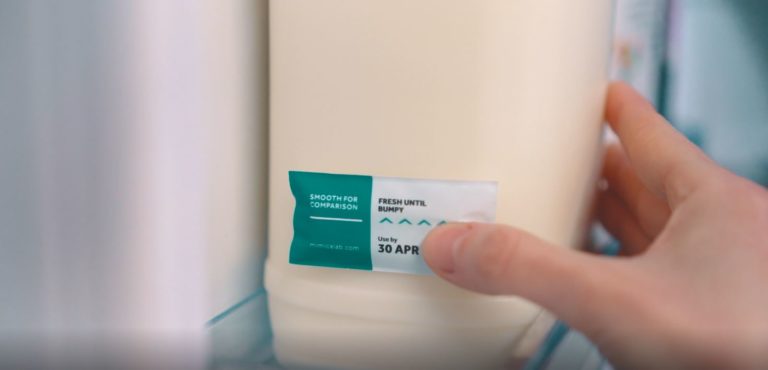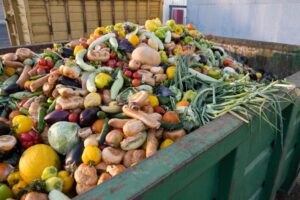Solveiga Pakštaitė is founder and director of Mimica, a food labeling technology startup that recently won the People’s Choice Award at Rabobank’s startup pitch event FoodBytes! in London. We caught up with her to find out more about how she created the technology and how it will be deployed.
Why did you launch Mimica?
The reason was a bit unusual and I actually didn’t think about food waste; that wasn’t the issue I set out to solve per se. I went to university to study industrial design at Brunel and in the final year we have to do a major project. The year previously I’d been working a lot with people with visual impairments as part of a charity project. And over the six-month project, I realized that visually impaired people struggle when buying fresh food because of expiry dates and it was affecting their health because of the subsequent food choices they had to make, such as processed foods where they don’t need to worry so much about expiry dates. So that was the problem is set out to solve; how to make expiry dates more accessible to everyone.
I realized quickly that expiry dates are actually pretty much useless to everyone, based on how inaccurate they have to be for the industry to mitigate for risk. The current system is not working when you know how much is thrown away; 60% of perfectly edible food is thrown away which is completely shocking to me. So I pivoted to look at the whole system and see where we could make improvements.
But my original focus continues to inspire me and we look to solve any ongoing development issues in a very inclusive and open-minded way, always seeing if we can look at something from a different perspective.
So you launched Mimica straight out of university?
Most people just leave their projects as they are. I filed a patent just before graduating, not expecting to use it, but as an academic exercise. But then two weeks into the first job I took I found out that I’d won the James Dyson award, and suddenly the press started talking about my technology and I had supermarkets knocking on my door; that market demand made it an exciting opportunity.
How does the tech work and how did you discover it?
It’s a tactile label that changes, feeling smooth when food is ok to eat and bumpy when it’s expired. The label inside has a bumpy layer on the bottom that’s always there with plastic ridges, which is covered by a solid gel that’s set on top when the label is made, all cased within a film. As the food starts to spoil, the gel turns to liquid — much like jelly would behave — so you can feel the bumps. The gel can be calibrated to have the same spoilage characteristics as the target food.
I came across this by working collaboratively with a chemist on campus who suggested some materials I could use. I’m a big believer in multi-disciplinary approaches to problem-solving as it can completely change your perspective on a problem or a solution.
How do you give the gel the spoilage characteristic of different foods?
We work with food manufacturers to use their data on the shelf-life of foods as they will have run tests to determine a date. We take the original data — understanding that the dates they put on food are way off so they can avoid any risks — and use them to determine when that food will spoil and match the gel to the way that food behaves. We can change certain elements or properties of the gel so that if food is best at 4 degrees Celsius and is brought out to 21 degrees, the gel will spoil at the same speed. Our IP is in how we calibrate the gel so I can’t say much, but for example, one parameter change we can make is a higher concentration gel that’s stronger.
So you started with milk – why?
Milk is interesting because it’s really regulated in the UK and Europe. Here are three types of milk: full fat, semi-skimmed and skimmed, so you just need three different labels and you can serve the whole UK market.
So this made it a low set-up for a huge market opportunity and easy to get started on and then provide the runway and resources we need to work on more complex foods such as meat and fish which is a really good opportunity for us.
For milk, we’ve started a pilot project with Arla, which is paying for the pilot.
How much funding have you raised to date?
We were really lucky with grants at the start and were entirely grant funded in the first two years raising about £250,000 worth of grants and prize money. We’re currently raising our seed round and just increased the target for £1.3 million after hitting our original target of £700,000. This round will enable us to go after our first customers and show the concept working in the market for the first time.
How will the deployment work? What does it look like?
Our labels will be made by a partner manufacturer in the UK in a dormant state; they will have to be activated as they are applied to the food. This was a large part of our design development; how to produce a label that’s not active as soon as it’s made as that would be a logistical nightmare. This activation method will depend on the food supplier so we are working on bespoke activation models but looking at what’s already happening in the processing line. It could be a motion, or the food goes through a roller. We want it to be activated without having to take an extra step.
What happens if a label is not activated? Will you have checks and balances in place?
We are obviously working hard on mitigating for that. For example, if a certain amount of pressure needs to be applied to activate it, in scenarios we would ensure that it’s twice the amount of pressure to remove the possibility of it not being activated. The whole point of doing these pilots is to monitor this kind of thing and continuously improve. We’re really looking forward to the way our efforts in the prototyping stage play out.
Why do your labels still have an expiry date – or use by date – on them? Is that the same date it would have had on it before Mimica? Would it not be better to have a sell-by date and then consumers use the mimica label to determine expiry?

You recently took part in FoodBytes! in London where you won the People’s Choice Award. How was it?
It was the most tangibly useful event we’ve done this year in terms of lead generation. Because of FoodBytes! we’re so crazy busy at the moment, in a good way! What made it uniquely useful were the people they managed to get into the room — all of Rabobank’s clients which is exactly who we want on-board. We didn’t enter to win but to have that opportunity to pitch on stage and answer their questions.
*This article was sponsored by FoodBytes! by Rabobank. Find out more about the AgFunder Network Partner program here.















Sponsored
International Fresh Produce Association launches year 3 of its produce accelerator